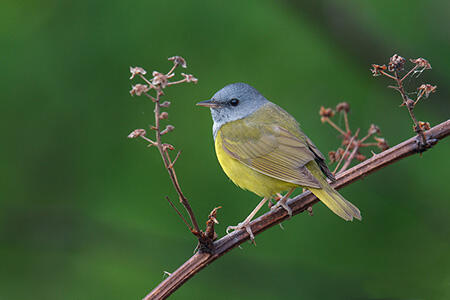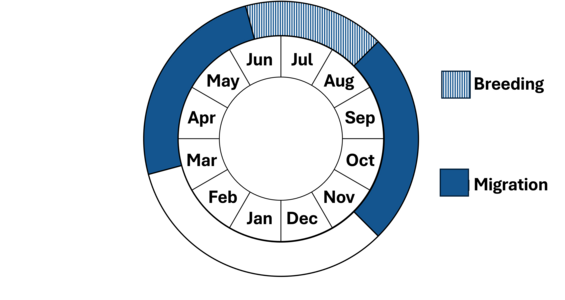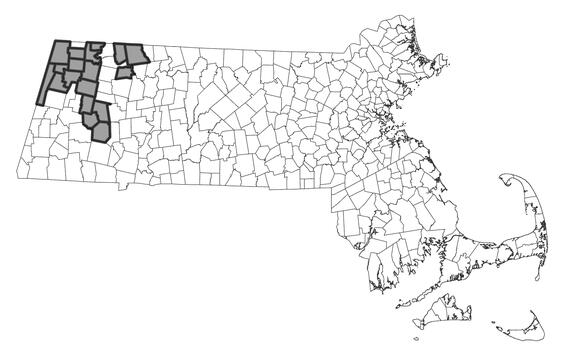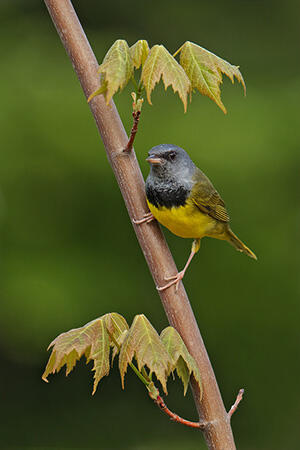- Scientific name: Geothlypis philadelphia
- Species of Greatest Conservation Need (MA State Wildlife Action Plan)
- Special Concern (MA Endangered Species Act)
Description

Mourning Warbler (Geothlypis philadelphia)
A rather secretive species, the mourning warbler is often difficult to observe, except when the male is singing from a perch. The back, wings, and tail are olive green, while the underside is mostly bright yellow, grading to yellow-olive on the sides. The head and throat are gray, forming a bib on the upper chest. The lower edge of the bib grades to black in males. The mourning warbler is a relatively small warbler, with an overall length of 13.3 cm (5.25 in) and a wingspan of 19 cm (7.5 in). Its song is repetitive and rhythmic with a rich, burry quality. The first part of the song is a single syllable repeated 3 to 7 times, followed by a lower syllable often repeated twice. The entire song is described as “churry, churry, churry, churry, chorry, chorry”. A special flight song is also given during the latter part of the nesting period, beginning with a series of chip notes as the male flies upward into the sky.
Life cycle and behavior

Phenology in Massachusetts. This is a simplification of the annual life cycle. Timing exhibited by individuals in a population varies, so adjacent life stages generally overlap each other at their starts and ends.
Mourning warblers typically arrive on their breeding grounds in the northeastern U.S. in mid to late May. Courtship and nesting follow soon after arrival. Nests are generally built on or close to the ground within dense cover, usually in brambles, clumps of weeds, grass tussocks, or tangles of low shrubs. The outer part of the nest is woven of dry leaves, grasses, sedges, vine stalks, and other materials.
The inner cup is typically lined with finer materials such as roots, hair, and finer sedges and grasses. Eggs are cream-colored and speckled with brown to black spots concentrated near the rounder end of the egg. Clutch size is 3-5 eggs, commonly 4; nests are sometimes parasitized by brown-headed cowbirds (Molothrus ater). Incubation lasts about 12 days and is performed solely by the female. The young leave the nest 8-9 days after hatching but are not capable of sustained flight for another week or two. The young are attended closely by their parents and generally remain on territory for approximately 3 weeks after leaving the nest. Diet consists of a variety of insects including caterpillars, spiders, and beetles.
Population status
Mourning warblers appeared to be increasing in abundance in Massachusetts as late as the 1950’s, and data from the North American Breeding Bird Survey (BBS) suggest that the species was increasing in abundance range-wide during the 1960s and 1970s. However, more recent BBS data indicate that mourning warblers have been declining range-wide since the 1980s, and the species has an annual rate of decline of 1.3% from 1966 to 2022. Populations of a number of wildlife species dependent on early successional habitats have been declining in New England during the past 50 years or more, likely the result of a declining rate of major forest disturbance, a simultaneous increase in the rate of forest re-growth and succession, and a steady increase in permanent loss of forest habitat to development. Data are too scant to estimate population trends of mourning warblers in Massachusetts, but the species appears to have been consistently rare and restricted in its distribution since at least 1975.
Distribution and abundance
The mourning warbler breeds from British Columbia to Labrador, into the Great Lakes region and east to northern New England, and south along the Appalachian Mountains into West Virginia. In Massachusetts, it has been observed in Berkshire, Franklin, Hampshire, and Hampden counties, with most observations occurring in northern Berkshire County.
Mourning warblers overwinter in southern Central America (Costa Rica, Nicaragua, and Panama) and northern South America (Colombia, Ecuador, and Venezuela), preferring humid habitats. The species occasionally overwinters in the Dominican Republic.

Distribution in Massachusetts. 1999-2024. Based on records in the Natural Heritage Database.
Habitat
Mourning warblers prefer to breed in clearings associated with disturbed woodlands and second-growth forests. In Massachusetts, most breeding individuals are observed in regenerating clear-cuts or other forest openings less than ten years old. Breeding sites typically occur in northern hardwood forest communities, sometimes with a spruce and/or fir component. At many such sites, there is a dense undergrowth of raspberries (Rubus spp.) or ferns. Most breeding sites are at higher elevations (e.g., Mount Greylock) and are somewhat sloped.
Healthy habitats are vital for supporting native wildlife and plants. Explore habitats and learn about conservation and restoration in Massachusetts.
Threats
Habitat loss and degradation may be the biggest threat facing this species. As a species that depends on patches of young forest habitat, forest maturation coupled with suppression of natural disturbances (e.g., fire) is thought to be the largest single factor causing its population decline. As with other songbirds, collisions with glass and predation from domestic cats are a major source of mortality of individuals. As Massachusetts is on the southern edge of the range for the species, climate change may threaten the population in the state.
Predation by domestic cats has been identified as the largest source of mortality for wild birds in the United States with the number of estimated mortalities exceeding 2 billion annually. Cats are especially a threat to those species that nest on or near the ground.
An additional threat to the species is collisions with buildings and other structures, as approximately 1 billion birds in the United States are estimated to die annually from building collisions. A high percentage of these collisions occur during the migratory periods when birds fly long distances between their wintering and breeding grounds. Light pollution exacerbates this threat for nocturnal migrants as it can disrupt their navigational capabilities and lure them into urban areas, increasing the risk of collisions or exhaustion from circling lit structures or areas.
Conservation

Given that the core range of the mourning warbler is in boreal forests of the northern United States and Canada, and that its distribution in Massachusetts is largely restricted to higher elevations, long-term persistence of breeding populations of the species in Massachusetts may be seriously challenged by climate change and its effects on forest-community structure. However, until those effects and their implications are better understood, certain activities that create forest openings in Massachusetts may improve habitat for mourning warblers and should be encouraged in the near-term. Mourning warblers appear to benefit from some forms of logging (including clear-cutting), especially those that result in dense growths of brambles and ferns. Active management of habitat in Massachusetts should be concentrated at higher elevations in the northwestern part of the state, wherever spruce and fir are significant components of the forest community. At minimum, canopy cover should probably be reduced to 50% or less within the treatment area. Although the typical territory of a mourning warbler is only 1-2 acres in size, treatments of 10 acres or more are preferable. Forest harvests should have irregular edges when possible, especially if treatment occurs near human habitation or other areas where mammalian nest predators such as raccoons and opossums are abundant.
Promote responsible pet ownership that supports wildlife and pet health by keeping cats indoors and encouraging others to follow guidelines found at fishwildlife.org.
Bird collision mortalities can be minimized by making glass more visible to birds. This includes using bird-safe glass in new construction and retrofitting existing glass (e.g., screens, window decals) to make it bird-friendly and reducing artificial lighting around buildings (e.g., Lights Out Programs, utilizing down shielding lights) that attract birds during their nocturnal migration.
References
Forbush, E. H. 1978. Birds of Massachusetts. Arno Press, New York, NY.
Griscom, L., and D. E. Snyder. 1955. The birds of Massachusetts. Peabody Museum, Salem, MA.
Petersen, W. R., and W. R. Meservey. 2003. Massachusetts Breeding Bird Atlas. Massachusetts Audubon Society and University of Massachusetts Press, Amherst, MA.
Pitocchelli, J. (2020). Mourning Warbler (Geothlypis philadelphia), version 1.0. In Birds of the World (P. G. Rodewald, Editor). Cornell Lab of Ornithology, Ithaca, NY, USA.
Sauer, J. R., J. E. Hines, and J. Fallon. 2022. The North American Breeding Bird Survey, Results and Analysis 1966 - 2022. Version 10.13.2007. USGS Patuxent Wildlife Research Center, Laurel, NY.
Sibley, D. A. 2000. The Sibley Guide to Birds. Alfred A. Knopf, Inc., New York., NY.
Contact
| Date published: | April 28, 2025 |
|---|